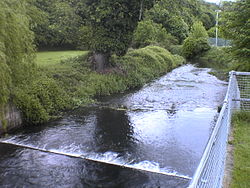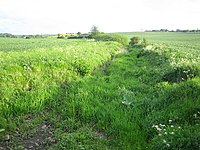River Beane: Difference between revisions
mNo edit summary |
|||
| (One intermediate revision by the same user not shown) | |||
| Line 1: | Line 1: | ||
[[File:RiverBeaneHertford.jpg|right|thumb| | [[File:BengeoBeaneRoad.jpg|right|thumb|350px|The Beane near Bengeo]] | ||
[[File:RiverBeaneHertford.jpg|right|thumb|250px|Weir on the Bean at Hartham Common]] | |||
The '''River Beane''' is a tributary of the [[River Lea]]. It rises to the south-west of [[Sandon, Hertfordshire|Sandon]], [[Hertfordshire]] in the hills northeast of [[Stevenage]] in [[Hertfordshire]]. | The '''River Beane''' is a tributary of the [[River Lea]]. It rises to the south-west of [[Sandon, Hertfordshire|Sandon]], [[Hertfordshire]] in the hills northeast of [[Stevenage]] in [[Hertfordshire]]. | ||
| Line 6: | Line 7: | ||
The lower Beane is more robust and there is regular flow through [[Watton-at-Stone]], [[Stapleford, Hertfordshire|Stapleford]] and [[Waterford, Hertfordshire|Waterford]] until the confluence with the River Lea at Hartham Common in [[Hertford]]. | The lower Beane is more robust and there is regular flow through [[Watton-at-Stone]], [[Stapleford, Hertfordshire|Stapleford]] and [[Waterford, Hertfordshire|Waterford]] until the confluence with the River Lea at Hartham Common in [[Hertford]]. | ||
==Conservation== | |||
Consideration has been given to find a way of replacing the water currently abstracted near Aston with water from a less environmentally damaging source. However, the River Lea's catchment area as a whole is under pressure, and it is difficult to find another source of fresh water. One possible approach to the restoration of the upper Beane is to use recycled water from sewage treatment works. Currently sewage from the Stevenage area is pumped down the Beane valley to Rye Meads near Hertford for treatment.<ref>[http://www.eera.gov.uk/GetAsset.aspx?id=fAAzADAAOQB8AHwARgBhAGwAcwBlAHwAfAAwAHwA0 Waste Water Report], Halcrow Group</ref> | Consideration has been given to find a way of replacing the water currently abstracted near Aston with water from a less environmentally damaging source. However, the River Lea's catchment area as a whole is under pressure, and it is difficult to find another source of fresh water. One possible approach to the restoration of the upper Beane is to use recycled water from sewage treatment works. Currently sewage from the Stevenage area is pumped down the Beane valley to Rye Meads near Hertford for treatment.<ref>[http://www.eera.gov.uk/GetAsset.aspx?id=fAAzADAAOQB8AHwARgBhAGwAcwBlAHwAfAAwAHwA0 Waste Water Report], Halcrow Group</ref> | ||
[[File:River Beane near Aston - geograph.org.uk - 172067.jpg| | [[File:River Beane near Aston - geograph.org.uk - 172067.jpg|right|thumb|200px|Dry bed of the Beane near Aston]] | ||
==References== | ==References== | ||
{{reflist}} | {{reflist}} | ||
{{ | {{commons}} | ||
==Outide links== | ==Outide links== | ||
*[http://www.wwf.org.uk/wwf_articles.cfm?unewsid=3875 Press release for WWF report "Riverside Tales"], 2010-04-28, WWF-UK | *[http://www.wwf.org.uk/wwf_articles.cfm?unewsid=3875 Press release for WWF report "Riverside Tales"], 2010-04-28, WWF-UK | ||
Latest revision as of 19:46, 14 June 2012


The River Beane is a tributary of the River Lea. It rises to the south-west of Sandon, Hertfordshire in the hills northeast of Stevenage in Hertfordshire.
Hertfordshire's population increased substantially in the second half of the twentieth century, and a licence was given to abstract water near Aston for Stevenage's water supply. The river has been adversely affected by over-exploitation of the chalk aquifer in its upper reaches. The photo shows a section south of Walkern where since the 1990s there has been only seasonal flow. The river was once big enough to power a watermill at Walkern and support watercress beds.
The lower Beane is more robust and there is regular flow through Watton-at-Stone, Stapleford and Waterford until the confluence with the River Lea at Hartham Common in Hertford.
Conservation
Consideration has been given to find a way of replacing the water currently abstracted near Aston with water from a less environmentally damaging source. However, the River Lea's catchment area as a whole is under pressure, and it is difficult to find another source of fresh water. One possible approach to the restoration of the upper Beane is to use recycled water from sewage treatment works. Currently sewage from the Stevenage area is pumped down the Beane valley to Rye Meads near Hertford for treatment.[1]

References
- ↑ Waste Water Report, Halcrow Group
| ("Wikimedia Commons" has material about River Beane) |
Outide links
- Press release for WWF report "Riverside Tales", 2010-04-28, WWF-UK
- Launch of the WWF report on the Rivers Beane and Mimram, Oliver Heald MP comments on WWF report.
